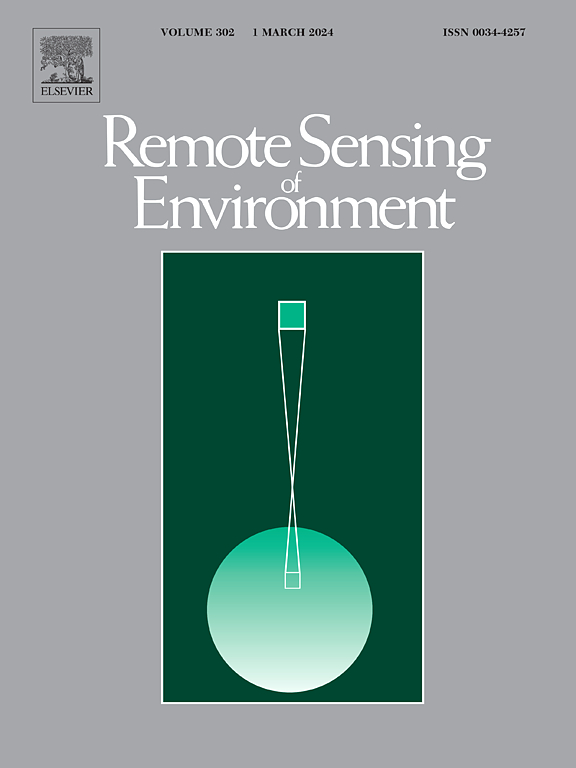A scalable, annual aboveground biomass product for monitoring carbon impacts of ecosystem restoration projects
IF 11.4
1区 地球科学
Q1 ENVIRONMENTAL SCIENCES
引用次数: 0
Abstract
Restoring natural ecosystems has the potential to remove billions of tons of CO2 annually through the end of the century, but rigorously measuring the climate impacts of restoration activities on the ground remains elusive. Ecosystem restoration interventions across hundreds or thousands of smallholder properties require robust above-ground biomass (AGB) products at high spatial (deca-metric: 10–30 m) resolution for annual monitoring, reporting, and verification (MRV). In addition to ongoing monitoring, historical AGB time series across the region are also necessary. Historical maps are for example needed for eligibility checks and the selection of appropriate counterfactuals, i.e., to establish a dynamic performance benchmark. We present a novel AGB product based on a recently developed foundation model leveraging progress in self-supervised learning (SSL) techniques from multi-spectral Earth Observation (EO) time series. The foundation model is non-contrastive and condenses all available spectral observations acquired within a year into a few, orthogonal and highly informative representations at 10 m (for Sentinel-2) and 30 m (for Landsat 7/8). Combined with spatially sparse Global Ecosystem Dynamics Investigation (GEDI) full-waveform measurements at two relative heights (RH95 and RH10), but otherwise without any further fine-tuning, we are able to estimate forest biomass with an RMSE of <25 Mg/ha, when validated against 38 in-situ AGB measurement sites across a range of agroforestry (cacao and oil palm) and restoration age classes. Compared to five openly available datasets – most of them not available at annual time steps – our approach reduces the RMSE by 15–55%. We demonstrate the scalability of our approach, by producing annual AGB maps covering the entire state of Para, Brazil, for the years 2013 to 2024. The approach is computationally efficient, fully self-supervised without relying on contrastive samples, and can therefore be scaled to global coverage, even under conditions of high cloudiness.
用于监测生态系统恢复项目的碳影响的可扩展的、年度地上生物量产品
到本世纪末,恢复自然生态系统有可能每年清除数十亿吨二氧化碳,但严格测量恢复活动对地面气候的影响仍然难以捉摸。数百或数千个小农户的生态系统恢复干预措施需要高空间(十米:10-30米)分辨率的强大的地上生物量(AGB)产品,以便进行年度监测、报告和验证(MRV)。除了持续监测外,还需要整个区域的AGB历史时间序列。例如,历史映射用于资格检查和选择适当的反事实,即建立动态性能基准。我们基于最近开发的基础模型,利用多光谱地球观测(EO)时间序列的自监督学习(SSL)技术的进展,提出了一种新的AGB产品。基础模型是非对比的,它将一年内获得的所有可用光谱观测压缩成10米(Sentinel-2)和30米(Landsat 7/8)的几个正交且信息丰富的表示。结合空间稀疏的全球生态系统动力学调查(GEDI)在两个相对高度(RH95和RH10)的全波形测量,但没有任何进一步的微调,我们能够估算森林生物量的RMSE为25 Mg/ha,在一系列农林业(可可和油棕)和恢复年龄类别的38个原位AGB测量点进行验证。与五个公开可用的数据集相比——其中大多数都不能在每年的时间步长上获得——我们的方法将RMSE降低了15-55%。通过制作2013年至2024年覆盖整个巴西帕拉州的年度AGB地图,我们展示了我们方法的可扩展性。该方法计算效率高,完全自我监督,不依赖于对比样本,因此可以扩展到全球覆盖范围,即使在高云量的条件下。
本文章由计算机程序翻译,如有差异,请以英文原文为准。
求助全文
约1分钟内获得全文
求助全文
来源期刊

Remote Sensing of Environment
环境科学-成像科学与照相技术
CiteScore
25.10
自引率
8.90%
发文量
455
审稿时长
53 days
期刊介绍:
Remote Sensing of Environment (RSE) serves the Earth observation community by disseminating results on the theory, science, applications, and technology that contribute to advancing the field of remote sensing. With a thoroughly interdisciplinary approach, RSE encompasses terrestrial, oceanic, and atmospheric sensing.
The journal emphasizes biophysical and quantitative approaches to remote sensing at local to global scales, covering a diverse range of applications and techniques.
RSE serves as a vital platform for the exchange of knowledge and advancements in the dynamic field of remote sensing.
 求助内容:
求助内容: 应助结果提醒方式:
应助结果提醒方式:


